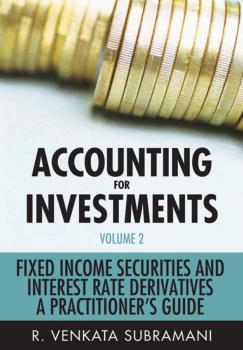ТОП просматриваемых книг сайта:
R. Subramani Venkata
Список книг автора R. Subramani VenkataAccounting for Investments, Fixed Income Securities and Interest Rate Derivatives. A Practitioner's Handbook - R. Subramani Venkata
Аннотация
A comprehensive guide to new and existing accounting practices for fixed income securities and interest rate derivatives The financial crisis forced accounting standard setters and market regulators around the globe to come up with new proposals for modifying existing practices for investment accounting. Accounting for Investments, Volume 2: Fixed Income and Interest Rate Derivatives covers these revised standards, as well as those not yet implemented, in detail. Beginning with an overview of the financial products affected by these changes—defining each product, the way it is structured, its advantages and disadvantages, and the different events in the trade life cycle—the book then examines the information that anyone, person or institution, holding fixed income security and interest rate investments must record. Offers a comprehensive overview of financial products including fixed income and interest rate derivatives like interest rate swaps, caps, floors, collars, cross currency swaps, and more Follows the trade life cycle of each product Explains how new and anticipated changes in investment accounting affect the investment world Accurately recording and reporting investments across financial products requires extensive knowledge both of new and existing practices, and Accounting for Investments, Volume 2, Fixed Income Securities and Interest Rate Derivatives covers this important topic in-depth, making it an invaluable resource for professional and novice accountants alike.
Аннотация
The 2008 financial crisis highlighted the need for responsible corporate governance within financial institutions. The key to ensuring that adequate standards are maintained lies with effective accounting and auditing standards. Accounting for Investments: Equities, Futures and Options offers a comprehensive overview of these key financial instruments and their treatment in the accounting sector, with special reference to the regulatory requirements. The book uses the US GAAP requirements as the standard model and the IFRS variants of the same are also given. Accounting for Investments starts from the basics of each financial product and: defines the product analyses the structure of the product evaluates its advantages and disadvantages describes the different events in the trade cycle elaborates on the accounting entries related to these events. The author also explains how the entries are reflected in the general ledger accounts, thus providing a macro level picture for the reader to understand the impact of such accounting. Lucidly written and informative, Accounting for Investments is a comprehensive guide for any professional dealing with these complex products. It also provides an accessible text for technology experts who develop software and support systems for the finance industry.


